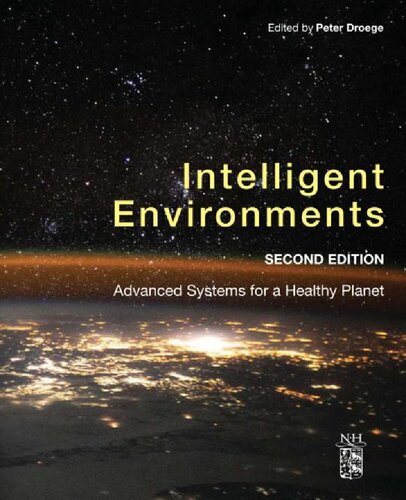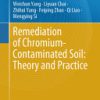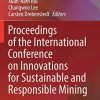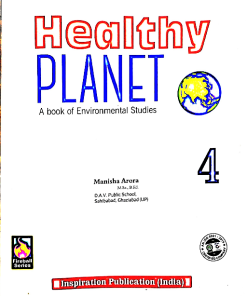Intelligent Environments Advanced Systems for a Healthy Planet 2nd Edition by Peter Droege ISBN 9780128202470 0128202475
$50.00 Original price was: $50.00.$25.00Current price is: $25.00.
Intelligent Environments Advanced Systems for a Healthy Planet 2nd Edition by Peter Droege – Ebook PDF Instant Download/Delivery: 9780128202470 ,0128202475
Full download Intelligent Environments Advanced Systems for a Healthy Planet 2nd Edition after payment

Product details:
ISBN 10: 0128202475
ISBN 13: 9780128202470
Author: Peter Droege
The promises and realities of digital innovation have come to suffuse everything from city regions to astronomy, government to finance, art to medicine, politics to warfare, and from genetics to reality itself. Digital systems augmenting physical space, buildings, and communities occupy a special place in the evolutionary discourse about advanced technology. The two Intelligent Environments books edited by Peter Droege span a quarter of a century across this genre. The second volume, Intelligent Environments: Advanced Systems for a Healthy Planet, asks: how does civilization approach thinking systems, intelligent spatial models, design methods, and support structures designed for sustainability, in ways that could counteract challenges to terrestrial habitability?
This book examines a range of baseline and benchmark practices but also unusual and even sublime endeavors across regions, currencies, infrastructure, architecture, transactive electricity, geodesign, net-positive planning, remote work, integrated transport, and artificial intelligence in understanding the most immediate spatial setting: the human body. The result of this quest is both highly informative and useful, but also critical. It opens windows on what must fast become a central and overarching existential focus in the face of anthropogenic planetary heating and other threats—and raises concomitant questions about direction, scope, and speed of that change.
- The volume uses a cross-disciplinary approach to exploring digitally enhanced, spatially relevant sustainability systems
- It critically queries the promise of information technologies and related support systems to help safeguard the habitability of the planet
- The new edition is fully updated and reorganized in thematically linked yet stand-alone chapters and is referenced to global bodies of knowledge for ease of discovery and access
- It includes copious images, maps, diagrams, and references to other media to enhance understanding
Intelligent Environments Advanced Systems for a Healthy Planet 2nd Edition Table of contents:
1. Intelligent environments 2—Advanced systems for a healthy planet
1. Intelligent environments in transition
2. The rise of intelligent environments: early inklings
3. The regenerative earth decade: intelligent environments for a habitable planet
4. The case for an intelligent planetary support environment
5. Conclusion
2. The Ruhr innovation ecosystem—From industrial brownfields to regenerative smart environments
1. Climate change and urban infrastructure transformations
2. The Ruhr Metropolis innovation ecosystem
3. Innovation ecosystems for regional structural change
4. References
3. Triangulum: the three point project—findings from one of the first EU smart city projects
1. European social cohesion, climate, urban innovation, and industrial development aims/H2020 and the green deal
2. The European Union (EU) initiatives on smart cities: innovation, resilience, climate change mitigation
3. The role of Triangulum
4. Aims and scope
5. Participating cities and their expectations
6. Leading technologies and their purpose
7. Expected outcomes and success measures
8. Case study: Eindhoven
9. Cooperation process and interaction
10. Outcomes and legacies of the project
11. Learning from Triangulum
4. Transactive electricity: how decentralized renewable power can support security, resilience and decarbonization
1. Introduction
2. The security and resilience challenge
3. The dispatchability deficit and transactive energy
4. Decentralization of price—from FIT to transactive electricity storage
5. Decentralizing and distributing the grid: optimizing digital technology with a purpose
6. How does the distributed, transactive electricity grid work?
7. Market mechanisms for a distributed, transactive electricity grid
8. Emerging roles for entrepreneurs in the decentralized, transactive electricity grid
9. Deregulation and reregulation for a distributed, transactive electricity grid
10. Conclusion
11. Short glossary of terms
5. Community inclusion currencies
1. Introduction
2. Real world applications
3. Currencies and blockchains
4. Methodology
5. Pay it forward
Glossary
6. Managing uncertainty/making miracles: understanding and strategizing for unpredictable outcomes in the implementation of intelligent government
1. Introduction
2. The uncertainty principle
3. Case studies
4. Lessons
7. Geodesign to address global change
1. Introduction: the global challenge
2. Geodesign and sustainable development
3. Strategic planning for significant change
4. Organizing geodesign
5. Collaborative negotiation as a geodesign method
6. Technology in support of geodesign
7. Strategic planning for global change: the International Geodesign Collaboration
8. The IGC conventions: a common “language” for geodesign
9. Two IGC case studies
10. The CAMKOX corridor: rethinking the growth of the London region
11. The Minneapolis Green New Deal: the effect of policy on place
12. Early adopter scenario
13. Late adopter scenario
14. Nonadopter scenario
15. How IGC studies have applied geodesign globally
16. Conclusion: Geodesign in global public practice
8. Smart working and flexible work arrangements: opportunities and risks for sustainable communities
1. Introduction
2. Telework and smart work: definitions and main features
3. Moving from tackling life-work balance toward a novel work organization
4. Contribution of smart working to the quality of the urban environment
5. Smart-working in the context of pandemic and postpandemic scenarios
6. Perspectives on the transformative potential of smart working
9. Intelligent spatial technologies for gender inclusive urban environments in today’s smart cities
1. Introduction
2. Methodological framework
3. Results: literature and practice-based
4. Discussion
5. Conclusion
10. Toward an intelligent mobility regime
1. Overview
2. Transport’s sustainability challenge
3. Key structural trends behind travel behaviors
4. Realizing the potential of intelligent mobilities
5. A multi-level perspective analysis
6. Niche innovations and regime change in public transport
7. The four types of intelligent mobility innovation
8. Getting from A to B—a framework for systemic transformation
9. Think big, start small—niche seeds of a system redesign
10. Exploring and supporting transition paths
11. Autonomous mobility in the built environment
1. Introduction
2. Overview of the autonomous vehicle sector
3. Autonomous vehicles and sustainability
4. Four urban pillars for defining a sustainable future with autonomous vehicles
5. Conclusion
12. Smart building and district retrofitting for intelligent urban environments
1. Current scope of smart retrofitting
2. Will energy digitalization and data services foster smart renovation?
3. Building renovation impact on cities’ sustainability and resilience: a step toward a healthier urban environment
4. Perspectives and recommendations
13. Scale matters: exploiting cross-scale interactions for a smart and sustainable built environment
1. Introduction
2. Cross-scaling: exploiting the benefits of multiscale considerations in building renovations
3. Overcoming the cross-scale transition barriers: from theory to practice
4. Discussion and outlook: finding a scale to fit
14. Ontologically streamlined data for building design and operation support
1. Introduction
2. Building performance data (BPD)
3. Building performance indicators
4. Ontological schema for building performance data
5. From data to application
6. BPD ontology implementation
7. Sustainably technology configuration support: an illustrative case study of ontologized data utilization
8. Conclusions
15. Digital City Science—a platform methodology for sustainable urban development
1. City science approaches in urban research
2. Principles, methods, and technologies
3. Convergence with urban sustainability
4. Sample studies and projects
5. Outlook: a new paradigm?
16. A software tool for net-positive urban design and architecture
1. Introduction
2. How STARfish differs from rating tools
3. How STARfish differs from lifecycle assessment
4. Unique structure of STARfish
5. Discussion and outlook
17. Strategies to improve energy efficiency in residential buildings in Ambon, Indonesia
1. Introduction
2. Methodology
3. Results
4. Discussion
5. Conclusion
18. Transactive electricity markets: case study RENeW Nexus
1. Introduction
2. Research question
3. Background
4. The project: RENeW Nexus—a study of localized transactive, electricity markets
5. Methodology
6. Results
7. Loco 1
8. Conclusions
Glossary
19. The Insight Engine 2.0: the body and biomimetic systems as intelligent environments
1. The body as intelligent environment
2. The Neosentient model environment
3. The enacted, embodied, embedded, extended approach, abstracted via biomimetics
4. Embodied computation
5. The Insight Engine 2.0—focusing on the production of a model for neosentience
6. Bisociation and poly-association
7. Some visualization strategies in the Insight Engine 2.0
8. The World Generator 2.0—programming by Quran Karriem
9. Initial research areas for the Insight Engine 2.0
10. Two different approaches to Neosentience—one top down (Rössler), one bottom up (Seaman)
11. A new combinatorial n-dimensional bioalgorithm
12. Why n-dimensional?
13. Ethics and redefining notions of bias
14. The scope of the research
Sustainable AI and EI
15. Conclusion
Index
People also search for Intelligent Environments Advanced Systems for a Healthy Planet 2nd Edition:
Tags: Peter Droege, Intelligent Environments, Advanced Systems, Healthy Planet
You may also like…
Children's Books - Others
Healthy Planet Environmental Studies For 5 2022nd Edition by Manish Arora 9385245120 9789385245121
Engineering - Telecommunications
Computers - Information Systems
Uncategorized
Uncategorized
Healthy Recipes: A Clean Cookbook with Delicious and Healthy Recipes 2nd Edition Booksumo Press











